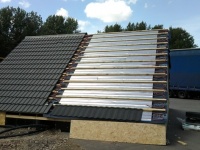
Ask anyone in the construction industry about foundations, and they will tell you that they are the most important part of a building. Yet when it comes to reducing energy in the built environment, foundations have, up until now, been overlooked.

‘The project has the potential to change building practice in foundation structures,’ explained Riffat. ‘Embodied carbon is now a important issue affecting decision making in the construction sector and the technology developed under this project not only complies with future requirements in this area but extends the role of foundation structures from their traditional function as a passive element of building design to a working component of building occupancy.’
Nottingham has contributed to the project in terms through design work for the heat pump and solar roof. Roger Bullivant has provided significant expertise in developing the System First and pile technology in a partnership with the University that has spanned over 12 years. As a result of the collaboration, students have had the opportunity to be at the forefront of innovative commercial activities and the practical application of sustainable technologies in the built environment.
Register now to continue reading
Thanks for visiting The Engineer. You’ve now reached your monthly limit of premium content. Register for free to unlock unlimited access to all of our premium content, as well as the latest technology news, industry opinion and special reports.
Benefits of registering
-
In-depth insights and coverage of key emerging trends
-
Unrestricted access to special reports throughout the year
-
Daily technology news delivered straight to your inbox










UK Enters ‘Golden Age of Nuclear’
Anybody know why it takes from 2025 to mid 2030's to build a factory-made SMR, by RR? Ten years... has there been no demonstrator either? Do RR...